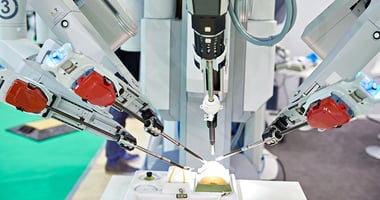Robotics are changing the face of almost every industry, with the manufacturing sector appearing to...
Transforming Traditional Farming Methods – Agricultural Robots
The world’s population continues to grow, creating an urgent need for food and a more efficient way of farming. To meet these necessities, today’s farmers are turning to technology, particularly agricultural robots. Agricultural robots are playing an increasingly crucial role in transforming traditional farming methods into sustainable, efficient operations. These robots are helping farmers address labor shortages and improve efficiency. Able to work around the clock performing tedious tasks that would otherwise be labor-intensive and time-consuming; they are making a dramatic impact on productivity.
Let’s look at some of the key areas where agricultural robotics are being used:
Precision Agriculture: Agricultural robots equipped with sensors and GPS technologies can collect data about soil conditions, crop health, and weather patterns. This information helps reduce waste and improve crop yields.
Planting and Seeding: Robotic systems can automate the process of planting seeds or transplanting seedlings. This ensures consistent seed spacing and depth, leading to more uniform and greater crop growth.
Weeding and Pest Control: Agricultural robots can identify and remove weeds from fields, reducing the need for chemical herbicides. Similarly, they can be used to monitor for pests and apply targeted treatments when necessary.
Harvesting: Harvesting robots can pick fruits, vegetables, and even specialty crops like grapes with precision and care. The Burro robot works side-by-side with farm workers. It’s gentle touch, ensures greater crop yield and less waste. https://burro.ai/
Monitoring and Maintenance: Drones equipped with cameras and sensors can monitor large fields for signs of disease, stress, or other issues. This early detection allows farmers to act before problems spread.
Greenhouse Management: Robots can manage tasks in controlled environments like greenhouses, such as adjusting lighting, temperature, and humidity to create optimal growing conditions.
Data Analysis and Decision Making: Agricultural robots generate vast amounts of data related to soil health, crop growth, weather patterns, etc. This data can help farmers make better decisions about planting, watering, fertilization, resource allocation, and overall farm management.
Efficiency: Robots can work around the clock, regardless of weather conditions, leading to improved productivity and reduced operational delays. Additionally, agricultural robots can perform tasks with high precision, leading to uniform crop growth and optimized resource usage.
Environmental Impact: Precision application of resources like water, fertilization, and pesticides reduces waste and minimizes the environmental impact of farming.
The Future of Farming
The safety of farmers using agricultural robots is an important consideration in modern farming practices. Their precise application minimizes exposure to harmful chemicals and reduces health risks for both farmers and consumers.
Grain robotic systems ensure grain quality without risking the lives of our hardworking farmers. Grain robots handle moving grains within silos and processing facilities. These robots can help with tasks like loading and unloading grain bins, transporting grain to different parts of a facility. Suffocation from engulfment and entrapment in grain bins, falls from heights and crushing injuries from grain handling equipment are some of the biggest accidents occurring in grain silos. The portable remote-controlled robot, the Grain Weavel uses augers and gravity to level grain, break crusts, conduct inspections, and feed grain into extraction augers.
It can even can dig itself out of up to 5 feet of grain, if accidentally buried. It can robotically maintain the quality of the grain while keeping farmers safe. https://www.grainweevil.com/
Challenges in the field of agricultural robotics include the high upfront costs of robotics systems, the need for robust and adaptable technology, and the integration of these systems into existing farming practices. As technology advances and the benefits become more apparent, the adoption of agricultural robotics is likely to increase, helping address the growing demands of global food production while promoting sustainable agriculture. The successful adoption of these technologies depends on addressing the technical, economic, and regulatory challenges involved.
Overall, agricultural robotics holds the potential to revolutionize the way farming is done by making it more efficient, sustainable, and productive. If managed effectively, agricultural robotics has the potential to enhance food production while reducing the environmental footprint of farming practices.



